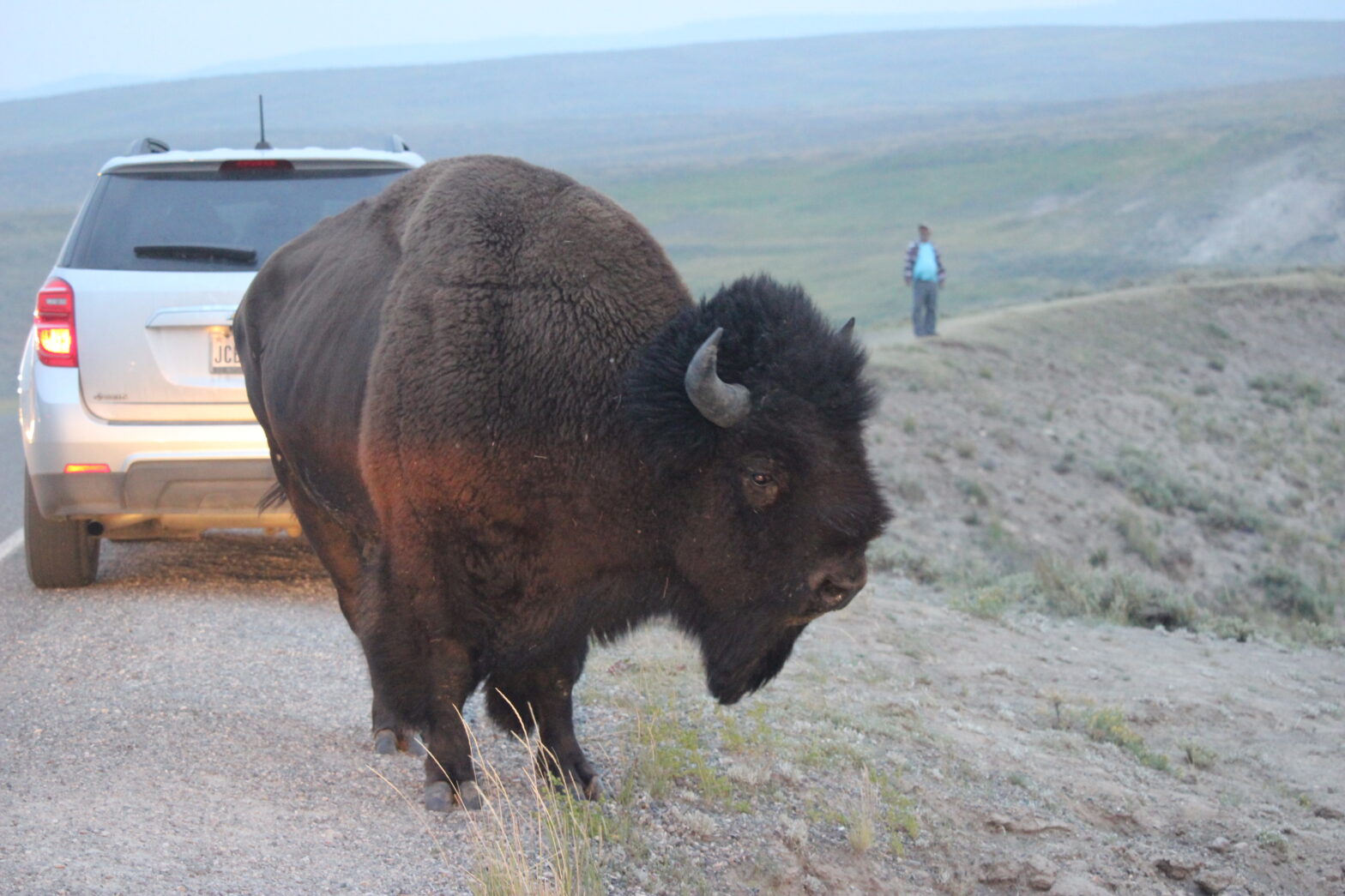If Lamar Valley is “The Serengeti of North America”, then its nearby cousin the Hayden Valley must be at least the Pampa of North America. The Hayden Valley frames the Yellowstone River as it flows northward from Yellowstone Lake towards its date with the Upper and Lower Falls, only 20 miles away. Those 20 miles are placid and winding across an open, rolling prairie with little streams flowing in from either direction. It’s genuinely beautiful and just looks like a place where big mammals would love to hang out. And they do! We hadn’t been driving north from Mud Volcano for more than a few minutes before Elizabeth, Pam and I saw a herd of elk just chilling on the other side of the valley. It turns out that that is not exactly uncommon: there are elk and bison at every bend in the river during the summer, socializing and doing whatever it is that they do. We stopped briefly to enjoy the two animal species, but I didn’t see any signs of what I was really looking for: the Wolf People. The Wolf People are a mysterious, self-important collective of people who tend to be older and take it upon themselves to be de facto trackers of the Yellowstone wolfpacks. They can be spotted at pull-offs with telephoto lens, vans, and a generally antisocial demeanor. Wherever they were late in the afternoon on August 16, I couldn’t seem to find them in Hayden Valley.
Instead, we drove through the valley in search of our destination: the Canyon Campground. Elizabeth wanted us to camp basically as close to the rim of the Grand Canyon of Yellowstone as we could – it’s centrally located, and one of the most beautiful natural wonders of the United States. Why wouldn’t you want to stay there? At the moment, Elizabeth had managed to book two campsites for what remained of our travel group, but they weren’t near each other. Elizabeth, Pam, and I were in one spot while Terri and Garrett were in another. If there’s anything I learned in planning and watching Elizabeth execute this trip, it’s that there’s nothing that can’t be solved by testing the patience of a park ranger. As we drove in, the Yellowstone River peeled slightly away from us to begin its tumble over the falls, while we reached an intersection that took us into Canyon Village. First of all, the village is absolutely huge – it has a general store, restaurants, an amphitheater, a visitor’s center, loop after loop of campsites, lodges, and cabins. It’s easy to get lost amid the hustle and the bustle of the village, but with a little bit of help from Elizabeth I found the Canyon campground office so that we could check in. That’s how you know it’s a wild place – the campground was so big that it had an office. Wild.
Elizabeth settled in to try to wheedle a park ranger into giving Terri and Garrett a spot closer to us while I sat out in a chair on the office’s porch, soaking in a warm albeit smoky day. If that sounds repetitive, well, I got enough service to check the forecast and:

That must have been the point forecast for the lowest spot I could click near Canyon Village, because let me tell you, time was going to prove those forecast temperatures optimistically high. For now, the forecast called for one more day of the record warmth that was once again scorching the Northwest, but then a merciful pattern shift was in store.
After a protracted discussion with the NPS staff, Elizabeth emerged triumphantly from the campground office. Somehow, she had managed to get Terri and Garrett into close proximity to us in one of the very back loops in the campground (I want to say we were in the J loop, but maybe I’m making that up). However she’d done it, there was no denying it: she’d done it again.
It was definitely getting towards dinner time when we got to our particular site. It wasn’t bad at all: shaded by immense lodgepoles in every direction, in the interior of the loop with the bathroom basically right behind our site, and plenty of space to pitch a pair of tents. I tried to set up the campsite as conscientiously as I could, not wanting a repeat of Elizabeth and my battle that morning (yes, somehow, that fight was the same day as this blog post). We hung some of the “engagement celebration” decorations from Taylor on the trees at our campsite and put folding chairs by the campfire ring that we would never end up using. I carefully arranged our suitcases at the foot of Elizabeth and my air mattress, then went over to Pam’s tent (which was really freaking annoying to put together) to inflate her air mattress for her. It always takes longer than I think it will to set up a campsite, particularly when you’re doing what I was and trying to make sure everything is set up just right to avoid future conflict. The result was a gnawing pit in my stomach by the time we were done. Time to go check out that spacious village and see what was open.
Like all of Yellowstone, Canyon was suffering from covid and worker shortages by this point, and many of the visitor services remained closed. As we repeatedly found during the week, that rubbed up against the typical Yellowstone hordes in late August to produce some overworked NPS and Xanterra staff. The end result was that despite not really struggling to find parking at the natural park features all week (Mud Volcano aside), we struggled with stuff like getting meals. And nowhere was this more exemplified than the half hour (or longer, it’s hard to remember) that we waited in line at the Canyon Eatery. The restaurant had a simple, cafeteria-style menu of a few popular options, and it also had lines literally stretching out the door and into the parking lot. If we wanted food, we didn’t have much choice than to wait, and admittedly it was a pretty nice day to be standing in line, so I didn’t complain too much. My stomach did, though.
In terms of places I wouldn’t expect a Fresh Wok, the middle of Yellowstone National Park is pretty high. But that was one of the main options at the cafeteria, with workers piling paper boxes high with rice and chicken and veggies and sauced up. Pam paid for ours while I scouted out a table in the outdoor seating area for all five of us. The food was a godsend after our quasi-lunch crisis earlier. There were no scraps left behind, and in the interim we got to hear of Terri and Garrett’s adventures finding a homemade teepee down at Duck Lake near West Thumb. We would split up again after dinner, with the Colemans heading over to see the canyon itself.
As for Elizabeth, Pam, and myself, we were returning to Hayden Valley. The sun, wherever it hid behind the orange-yellow screen of smoke, was terminating its descent toward the vast western horizon. This meant that we were getting to the best time of day to see wildlife. So far in the last 24 hours, I’d seen a coyote, deer, elk, and bison, but I was getting greedy. Maybe Hayden Valley would have some wolves out hunting at this time of night.
If my goal was to be a pack of wolves just roaming on the slopes, then I was to be disappointed. By any other standards, though, this was a classic Yellowstone evening. We hadn’t gone more than 3 minutes before stopped cars indicated that something was on the road off to our right. When I trained the telephoto lens on the target, it turned out to be a herd of elk good-timing it near the treeline.
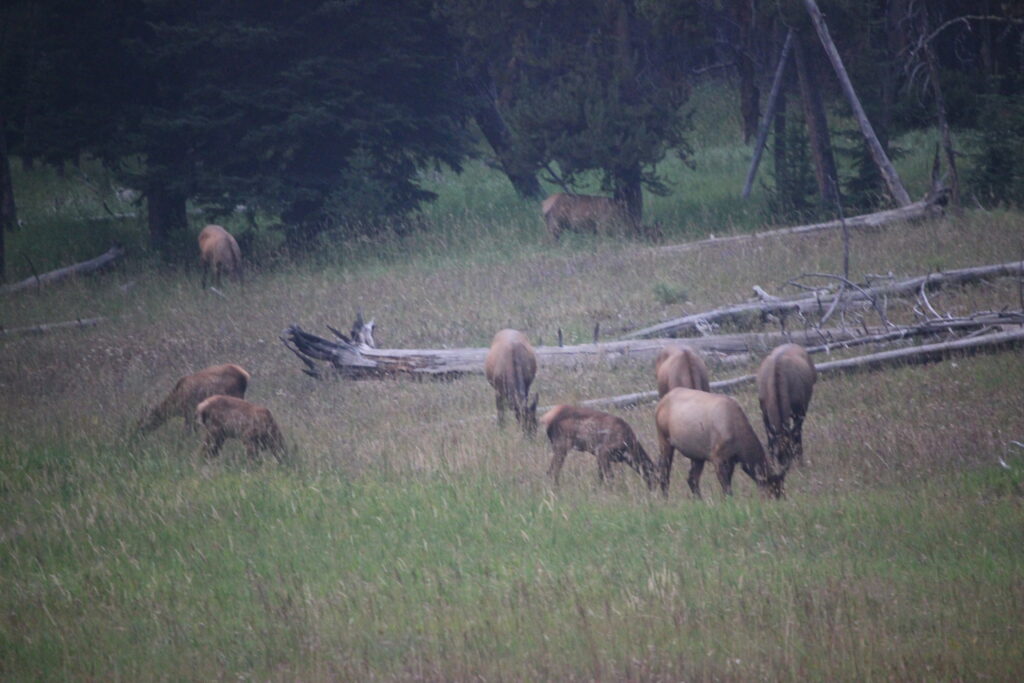
We continued southbound back into the wide-open expanse of the Valley. Plenty of other cars were there, choking off the pull-offs in both directions. It would appear from them that the main draw of this evening in Hayden Valley were the bison, which were everywhere doing whatever they wanted. We came to a broad pull-off in one of the most picturesque spots you could imagine – we sat upon a bluff overlooking the valley bottom on both sides. To our right, this little creek called Trout Creek came winding in, making the loop-de-loops that only alluvial creeks can do along the foot the of the bluff, while the rest of Hayden Valley sprawled toward the Yellowstone a few hundred yards to our left. And the entire place was crawling with bison. Big, lumbering bison, in no hurry to get where they were going. Baby bison clinging to their mothers. Bison rolling in the dusty late-summer ground. Everywhere you looked, that was it – bison.
Pam found the bison experience quite startling, particularly when one decided to cross the road right in front of us. We were safely in our car, so I didn’t think the situation was cause for alarm, but I recognize that it isn’t every day that a one-ton mammal crosses 15 feet in front of you.
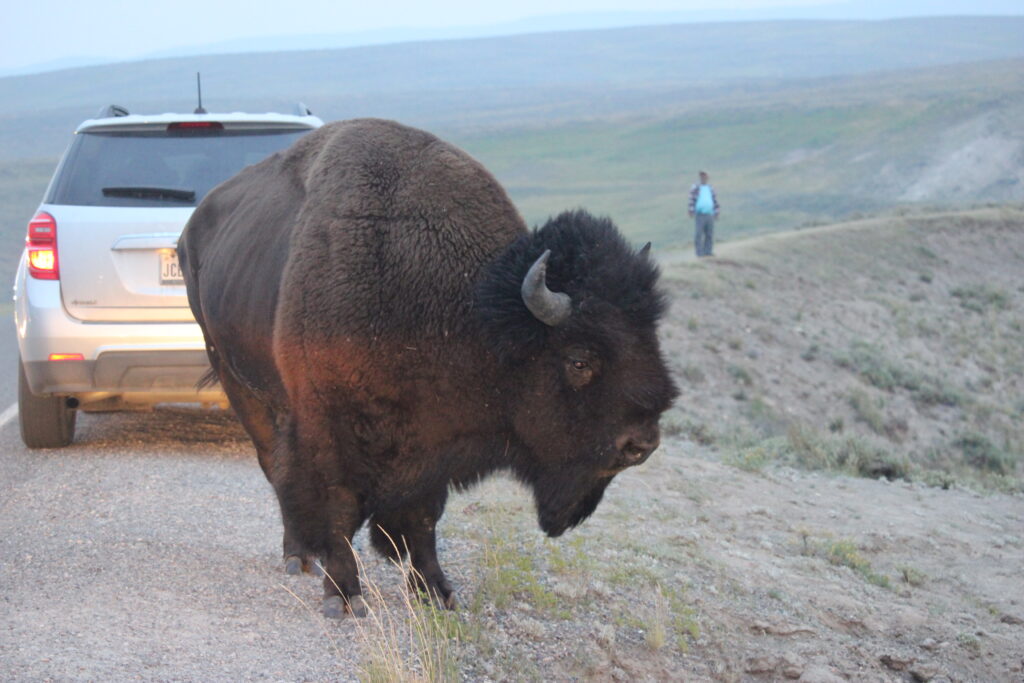
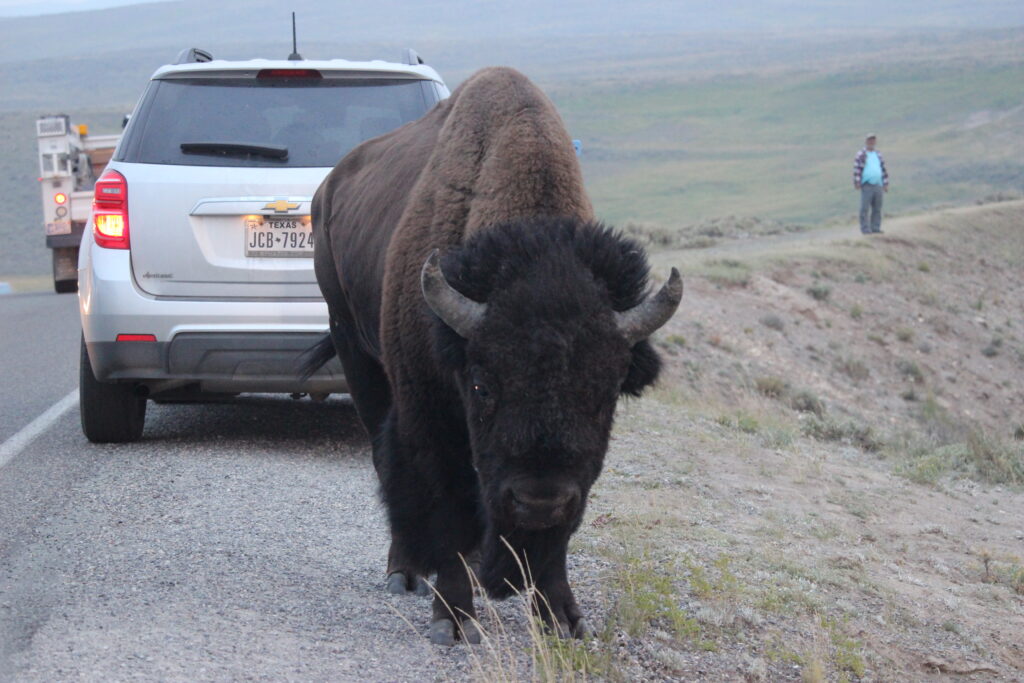
And then he was gone, to run surprisingly nimbly down the side of the bluff into Trout Creek. It was that run that led me to realize that we don’t want to be messing with bison. Those are some athletics piles of hamburger.
We stayed for a bit longer, giving me a chance to revel in the once-ubiquitous bovine that dominated the heartland of America. For thousands of years, these things had a free range from Yellowstone all the way to the East Coast. Now, the Hayden Valley herd serves as one of the last reminders of that never-to-return era. They don’t know anything about that. These several thousand bison roaming a park the size of Rhode Island just know that outside of the wolves, and the bears, and the mysterious creatures in the metal machines, they are in charge.
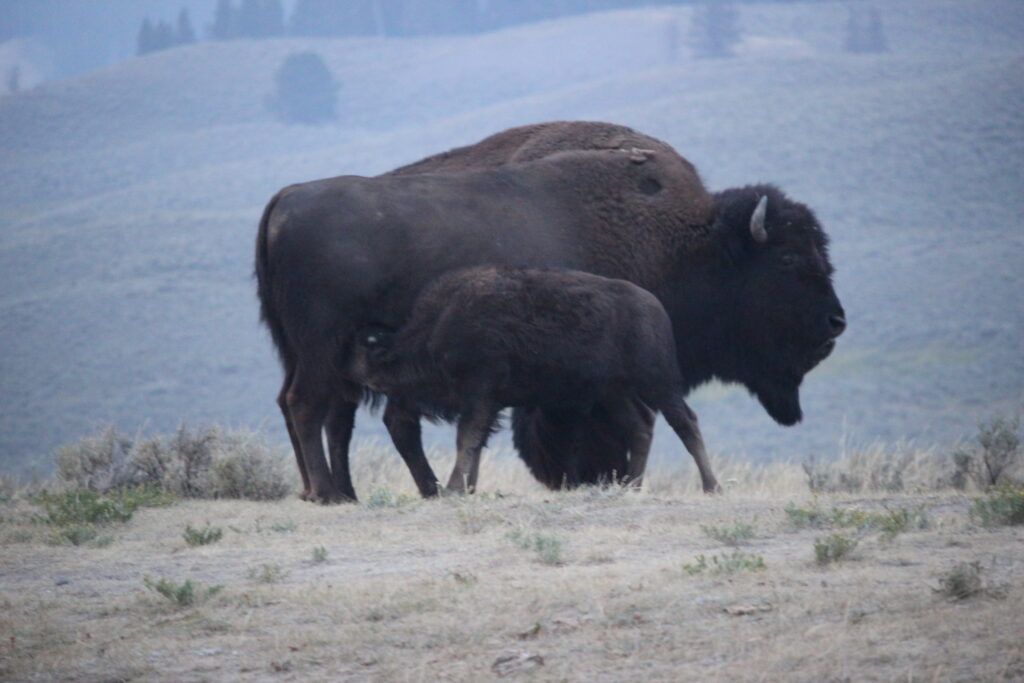
Yellowstone has shocking beauty to its thermal features, and to its wide-0pen panoramas, waterfalls, rivers, and mountains, but to me, this is the best part of the park. It serves as a portal from the not-distant past before humans came along and ruined everything.
By this point, it was getting dark and we were running out of light for me to get pictures with. Elizabeth and Pam agreed that it was probably time to head back to our campsite and get some rest. After all, for as big a day as today was, tomorrow promised to be even bigger – maybe the most action-packed (and if it wasn’t for one little diamond, maybe the most memorable) day of the trip awaited.

